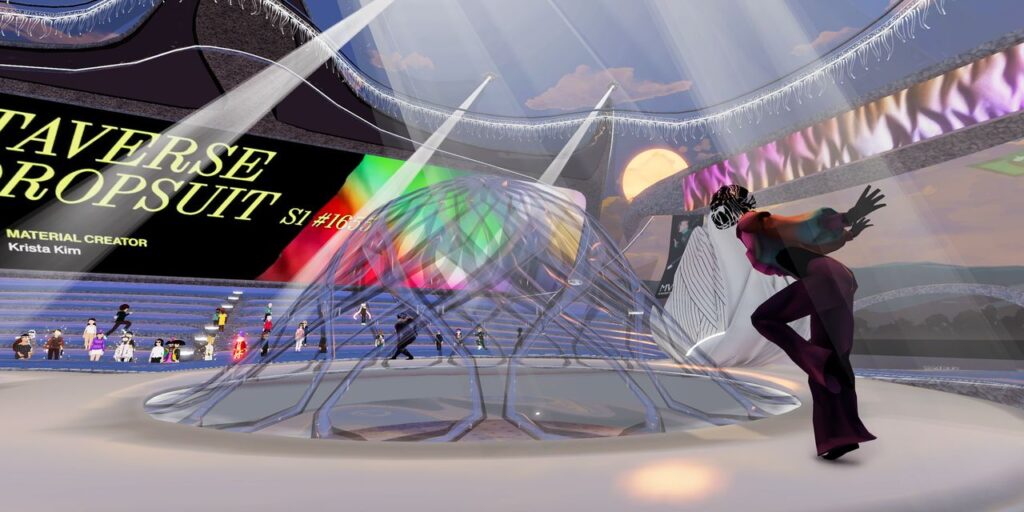For fashion fans, and everyone else, 2022 will be remembered as the year the metaverse went mainstream.
Ever since Mark Zuckerberg announced last October the corporate name change from Facebook to Meta, the writing was on the wall. A virtual wall, of course. Soon thereafter, came all the signs of a cultural tipping point—the Super Bowl’s wave of ads for cryptocurrency exchanges ( LeBron James for crypto.com, Larry David for FTX), the metaverse jokes and sketches on Saturday Night Live, and Snoop Dogg’s release of the first music video set in the metaverse, featuring a digitized avatar of the rap mogul smoking blunts and chilling in his “Snoopverse,” a virtual world he’s building online (early access passes to which run $2,000 a pop).
Fashion designers are paying attention. Flogged by fashion’s ongoing sustainability problem, and more recent supply-chain issues, labels are looking for some uplift. “In the real world, possibilities are limited,” says designer Philipp Plein. “The metaverse opens a whole new frontier.”
Plein, whose luxury brand now accepts more than 20 different cryptocurrencies at its online and brick-and-mortar shops, recently dropped $1.4 million to buy virtual real estate in Decentraland, a popular online platform that enables users to build an immersive 3-D metaverse experience. He erected a 120-meter-high virtual skyscraper in time for Metaverse Fashion Week, or MVFW, the world’s biggest all-digital fashion event, held in Decentraland over four days in March.
Unlike fashion weeks in real life, MVFW was free and open to the public, featuring avatar models, animated runways and after-parties, with more than 70 brands and artists, including Karl Lagerfeld, Tommy Hilfiger, Elie Saab, Cavalli, Etro, Dolce & Gabbana, Estée Lauder, and Selfridges, plus digital-native creators—makers of virtual, not actual, clothes—like Auroboros, Fewocious, and The Fabricant
“By their nature, brands tend to expand and create their own universe,” Plein says, noting fashion designers’ entry into home decor, hospitality, automobiles, and more. In the metaverse, he suggests, one could have a “luxury-brand zoo, hospital, [even a] state with its own cryptocurrency.”
The Etro store in Decentraland, which sold metaverse fashion collections
Courtesy of Decentraland
Digital Runway
The fashion industry has been dipping its pedicured toe in these waters for a few years, whether we’re talking the metaverse itself (alternate 3-D environments accessed via virtual reality headsets and online), platforms wearables (the digital garments your avatar wears on those platforms), nonfungible tokens (aka NFTs, one-of-a-kind collectibles
in the form of digital images, videos, or audio files), or cryptocurrency (the digital dollars used in the metaverse to buy wearables, NFTs, and more).
Last year saw Christie’s auction off a Gucci NFT, the first from a luxury brand, fetching $25,000. A “Baby Birkin” NFT inspired by the famous Hermès handbag (this one in animated form, depicting a translucent bag and a developing fetus within) was created by two Los Angeles artists, not the brand itself, and generated a major buzz, selling at auction for $47,000. Paris Fashion Week offered NFTs to select guests. Burberry, Givenchy, and Louis Vuitton followed. Nike bought virtual-sneaker outfit RTFKT and partnered with Roblox (a metaverse platform) to create its immersive Nikeland. Adidas bought up “land” for its own space in the Sandbox (another metaverse platform).
“We’re living in a time when technology continues to blur the lines between our physical and digital lives,” says Giovanna Graziosi Casimiro, head of MVFW at Decentraland. MVFW drew 108,000 unique attendees. They strolled sci-filike venues, some in garb bearing wings fantastic, dragon heads, illuminated ponytails, and twinkly orbiting lights. Others in hoodies or gym shorts.

Decentraland’s primary catwalk.
Courtesy of Decentraland
Democratized Luxury
Such democratization fuels enthusiasm for the metaverse.
“Very few people have access to this crazy luxury world in real life,” says Sofia Sanchez de Betak, whose Chufy brand is typically sold at Neiman Marcus, Saks Fifth Avenue, and The Webster. “This is a way for many people to get a glimpse of it.”
Chufy built a virtual pop-up shop in Decentraland’s fashion district for MVFW. It looked like a tony shop along Paris’ Avenue Montaigne, but boasting a geisha print exterior and floating mannequins and 3-D waves within.
For Sanchez de Betak, the metaverse feeds a new kind of wanderlust, and an excitement reminiscent of the days when places like Cuba or Myanmar opened wide to tourism. “It’s like traveling into another dimension,” she says.
There are kinks in the metaverse, for sure. At present, metaverse technology differs on each platform, so a fab NFT bought on one site cannot be worn on another. And the environmental cost is debatable—proponents emphasize that virtual fashion may quench our hunger for fast fashion and help save the environment. Naysayers point out that the cryptocurrencies underpinning all this activity are linked to blockchains, the digital ledgers that verify these transactions, require banks of computers and vast amounts of energy.
Still, a designer can dream.
“We’re exploring,” says Sanchez de Betak. “To the generation already in that world, we’re just saying hi, trying to figure out what it’s about.”
This article appeared in the June 2022 issue of Penta magazine.
.

